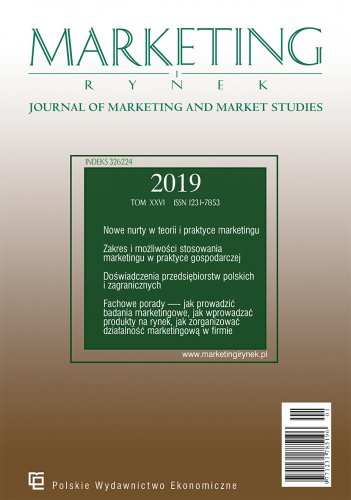Market aspects of sustainable construction on the example of The Crystal building
Nowadays, striving for practical implementation of the sustainable development concept more and more often determines the directions of market institutions' activities and, above all, the innovations they implement. These organisations pay special attention not only to the optimisation of production and distribution processes, but also to the functionality and efficiency of the buildings in which their offices or shops are located. It is worth pointing out that buildings can fulfil the triple bottom line concept — contributing to achieving economic, social and environmental goals by market institutions. A modern organisation, when building its factory or office buildings, should pay attention not only to the visual attractiveness of the building, but also to its functionality, low maintenance costs, social usefulness and minimising negative impact on the natural environment. The main aim of the article is to present the features that meet the requirements of sustainable development on the example of The Crystal building and to indicate the market benefits resulting from the use of this type of solutions. Particular attention was paid to economic, social and environmental profits. As part of the analysis, the case study method was used, based on the use of secondary data. Based on the considerations, it was found that The Crystal building is distinguished not only by its visually unique design, but also it is an integral part of its surroundings. It can serve as an inspiration for market institutions that strive to deliver more sustainable products.
References
Bibliografia/References
Agrawal, S. i Singh, R. (2019). Analyzing disposition decisions for sustainable reverse logistics: Triple Bottom Line approach. Resources, Conservation and Recycling, 150. https://doi.org/10.1016/j.resconrec.2019.104448
Broman, G. I. i Robert, K-H. (2017). A framework for strategic sustainable development. Journal of Cleaner Production, 140, 17–31. https://doi. org/10.1016/j.jclepro.2015.10.121.
Bruns, A. (2011). Olympian Ideals. https://siteselection.com/theEnergyReport/2011/nov/sustainability.cfm (22.05.2021).
designbuild-network.com. The Crystal by Siemens, London. https://www.designbuild-network.com/projects/the-crystal-by-siemens-london/ (22.05.2021).
Diepenmaat, H., Kemp, R. i Velter, M. (2020). Why Sustainable Development Requires Societal Innovation and Cannot Be Achieved without This. Sustainability, 12(3). https://doi.org/10.3390/su12031270
Dittwald, A. (2007). Nadeszła epoka „kryształu” czyli rewitalizacja i rozbudowa Królewskiego Muzeum Ontario w Toronto. Muzealnictwo, (48).
Drucker P. (1973). Management. New York: Harper & Row.
Flejterski, S. (2009). Determinanty rozwoju wielkich miast na przykładzie Szczecina. Wielkie miasta, aglomeracje, metropolie. Zeszyty Naukowe Uniwersytetu Szczecińskiego. Ekonomiczne Problemy Usług, 529(30).
ISG Ltd (2021). Case Study — The Crystal London. https://www.isgltd.com/en/who-we-are/sustainability/case-study/sustainability-the-crystal (12.07.2021).
Jasiński, A. (2011). Marketing innowacji na rynku dóbr zaopatrzeniowo-inwestycyjnych. Zeszyty Naukowe Uniwersytetu Szczecińskiego. Ekonomiczne Problemy Usług, 653(69), 93–108. https://doi.org/10.33141/po.2020.08.02
Jasiński, A. (2020). Gdzie innowacja spotyka się z marketingiem. Aspekty teoretyczne. Przegląd Organizacji, (8), 12–19.
Jia, M., Komeily, A., Wang, Y. i Srinivasan, R. S. (2019). Adopting Internet of Things for the development of smart buildings: A review of enabling technologies and applications. Automation in Construction, (101), 111–126. https://doi.org/10.1016/j.autcon.2019.01.023
Kamiński, J. (2019). Zrównoważony marketing w zrównoważonym świecie — cz. 2. Marketing i Rynek, (3), 3–16. https://doi.org/1033226/1231-7853.2019.3.1
Kamionka, L. (2010). Standardy architektury zrównoważonej jako istotny czynnik miasta oszczędnego na przykładzie wybranych programów certyfikacyjnych. Czasopismo Techniczne. Architektura, 107(14), 27–38.
Kamionka, L. (2012). Architektura zrównoważona i jej standardy na przykładzie wybranych metod oceny. Kielce: Samodzielna Sekcja ,,Wydawnictwo Politechniki Świętokrzyskiej”.
Kotler, Ph. (1994). Marketing. Analiza, planowanie, wdrażanie i kontrola. Warszawa: Gebethner i Ska.
Leonidas, A. (2017). Smart utopia VS smart reality: Learning by experience from 10 smart city cases. Cities, (63), 128–148. https://doi.org/10.1016/j.cities.2016.10.005
london.gov.uk (2021). Smart London Plan. https://www.london.gov.uk/sites/default/files/smart_london_plan.pdf (26.05.2021).
Mazur-Wierzbicka, E. (2014). Ekoinnowacje — istotny element zrównoważonego budownictwa. Handel Wewnętrzny, (5), 138–148.
Nasereddin, M. i Price, A. (2021). Addressing the capital cost barrier to sustainable construction. Developments in the Built Environment, (7). https://doi.org/10.1016/j.dibe.2021.100049
Oke, A., Aghimien, D., Aigbavboa, C. i Musenga, Ch. (2019). Drivers of Sustainable Construction Practices in the Zambian Construction Industry. Energy Procedia, 158, 3246–3252. https://doi.org/10.1016/j.egypro.2019.01.995
Omri, A. i Mabrouk, N. B. (2020). Good governance for sustainable development goals: Getting ahead of the pack or falling behind? Environmental Impact Assessment Review, (83). https://doi.org/10.1016/j.eiar.2020.106388
Pabian, A. (2013). Działalność promocyjna w koncepcji sustainability. Marketing i Rynek, (8), 12–17.
Pilarczyk, B. (2011). Innowacje w komunikacji marketingowej. Zeszyty Naukowe Uniwersytetu Ekonomicznego w Poznaniu. Polskie Towarzystwo Ekonomiczne, (9), 271–286.
Szruba, M. (2021). Budownictwo wspiera ekologię. Nowoczesne Budownictwo Inżynieryjne, 2(95), 12–30.
The Crystal (2015). The Crystal: one of the most sustainable buildings in the world. https://www.thecrystal.org/wp-content/uploads/2015/04/The-Crystal-Sustainability-Features.pdf (28.05.2021).
The Crystal (2021). About The Crystal. https://www.thecrystal.org/about/ (28.05.2021).
Wasilik, K. (2014). Trendy w zachowaniach współczesnych konsumentów — konsumpcjonizm a konsumpcja zrównoważona. Konsumpcja i Rozwój, 1(6), 66–74.
Whole Building Design Guide Sustainable Committee (2014). https://www.wbdg.org/design-objectives/sustainable (12.07.2021).
Wilczak, A. (2019). Młodzi dorośli Polacy wobec redystrybucji dóbr używanych. Marketing i Rynek, (2), 16–30. https://doi.org/1033226/12317853.2019.2.2
WilkinsonEyre (2021). WilkinsonEyre Projects — The Crystal. https://www.wilkinsoneyre.com/projects/the-crystal (22.05.2021).
Yang, D., Vladimirova, D. i Evans, S. (2017). Creating and Capturing Value through Sustainability: the Sustainable Value Analysis Tool A new tool helps companies discover opportunities to create and capture value through sustainability. Research Technology Management, 60(3), 30–39. https://doi.org/10.1080/08956308.2017.1301001
Yu, L., Nazir, B. i Wang, Y. (2020): Intelligent power monitoring of building equipment based on Internet of Things technology. Computer Communications, 157, 76–84. https://doi.org/10.1016/j.comcom.2020.04.016
Zasuwa, G. (2019). Value preferences and consumer sustainable choices. Marketing i Rynek, (1), 14–29. https://doi.org/1033226/1231-7853.2019.1.2

